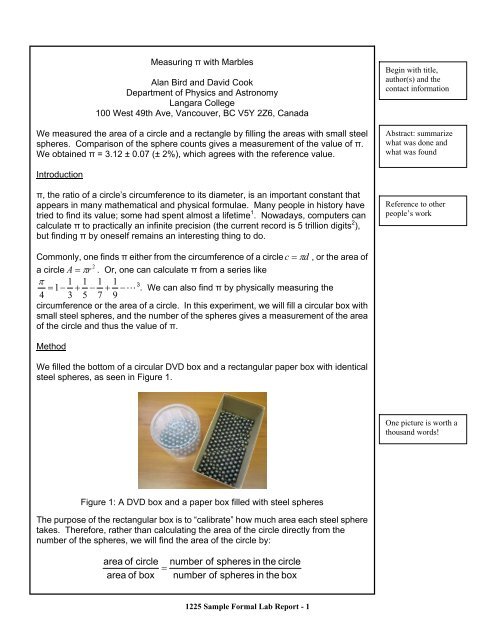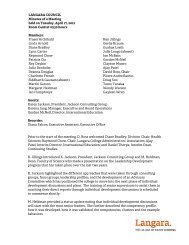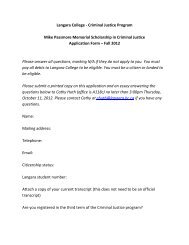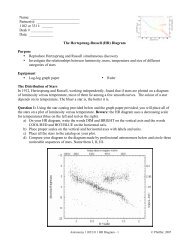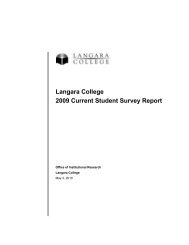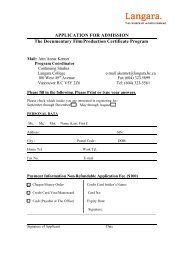Sample Formal Lab - Langara College
Sample Formal Lab - Langara College
Sample Formal Lab - Langara College
Create successful ePaper yourself
Turn your PDF publications into a flip-book with our unique Google optimized e-Paper software.
Measuring π with Marbles<br />
Alan Bird and David Cook<br />
Department of Physics and Astronomy<br />
<strong>Langara</strong> <strong>College</strong><br />
100 West 49th Ave, Vancouver, BC V5Y 2Z6, Canada<br />
We measured the area of a circle and a rectangle by filling the areas with small steel<br />
spheres. Comparison of the sphere counts gives a measurement of the value of π.<br />
We obtained π = 3.12 ± 0.07 (± 2%), which agrees with the reference value.<br />
Introduction<br />
π, the ratio of a circle’s circumference to its diameter, is an important constant that<br />
appears in many mathematical and physical formulae. Many people in history have<br />
tried to find its value; some had spent almost a lifetime 1 . Nowadays, computers can<br />
calculate π to practically an infinite precision (the current record is 5 trillion digits 2 ),<br />
but finding π by oneself remains an interesting thing to do.<br />
Commonly, one finds π either from the circumference of a circle c = πd<br />
, or the area of<br />
2<br />
a circle A = πr<br />
. Or, one can calculate π from a series like<br />
π 1 1 1 1 3<br />
= 1−<br />
+ − + −L<br />
. We can also find π by physically measuring the<br />
4 3 5 7 9<br />
circumference or the area of a circle. In this experiment, we will fill a circular box with<br />
small steel spheres, and the number of the spheres gives a measurement of the area<br />
of the circle and thus the value of π.<br />
Method<br />
We filled the bottom of a circular DVD box and a rectangular paper box with identical<br />
steel spheres, as seen in Figure 1.<br />
Figure 1: A DVD box and a paper box filled with steel spheres<br />
The purpose of the rectangular box is to “calibrate” how much area each steel sphere<br />
takes. Therefore, rather than calculating the area of the circle directly from the<br />
number of the spheres, we will find the area of the circle by:<br />
area of circle number of spheres in the circle<br />
=<br />
area of box number of spheres in the box<br />
1225 <strong>Sample</strong> <strong>Formal</strong> <strong>Lab</strong> Report - 1<br />
Begin with title,<br />
author(s) and the<br />
contact information<br />
Abstract: summarize<br />
what was done and<br />
what was found<br />
Reference to other<br />
people’s work<br />
One picture is worth a<br />
thousand words!
Before counting, we shook the boxes and adjusted the positions of the spheres by<br />
hand to maximize the number of spheres that can fill in. We also checked that all the<br />
spheres were touching the bottom.<br />
Result<br />
We counted 76 spheres in the DVD box and 149 spheres in the paper box. The<br />
numbers were each counted twice and two counts gave identical results. For<br />
reference, the spheres were (1.20 ± 0.05) cm in diameter.<br />
We used a 30-cm student ruler to measure the lengths. To measure the diameter of<br />
the DVD box’s bottom, we made 3 measurements at 3 different directions, from inner<br />
edge to inner edge. All three measurements gave same value of (12.40 ± 0.05) cm,<br />
therefore the diameter of the DVD box was (12.40 ± 0.05) cm.<br />
To measure the length of the paper box, we made 4 measurements at the different<br />
places of the box. Unfortunately, because the box was not transparent, we had to put<br />
the ruler on top of the box and try to read the length of the bottom. The results we got<br />
were 21.3, 21.2, 21.3, and 21.2 in cm, with an average of 21.25 cm. Uncertainty was<br />
decided to be ± 0.1 cm.<br />
The width was similarly measured to be 11.0, 11.1, 11.1 and 11.0 in cm, with an<br />
average of 11.05 cm. Uncertainty was also ± 0.1 cm.<br />
This data combined gave π = 3.12 ± 0.07 (± 2%).<br />
Conclusion<br />
By physically measuring the area of a circle, we found π to be 3.12 ± 0.07 (± 2%).<br />
Discussion<br />
Our result agrees well with the reference value 3.1415926(…) 2 , but the uncertainty is<br />
big.<br />
The numbers of the spheres were taken to have no uncertainty (see next paragraph),<br />
so the big uncertainty comes from the length measurements. If we can find a large,<br />
truly rectangular, rigid, transparent box, we can greatly improve the uncertainty. If we<br />
can achieve ± 0.05 cm in 50.00 cm, then we can bring down the uncertainty of π from<br />
0.07 to 0.01.<br />
We have ignored a number of systematic effects. Most obvious effect is that the<br />
spheres do not cover the entire area: there are gaps between them. In other words,<br />
our counted numbers do have uncertainty, and the “true number”, the number of<br />
spheres covering the area without gaps, should be larger. Naturally, the smaller the<br />
box is, the more significant are the gaps, and more the counted number is off.<br />
Because our DVD box was smaller than the paper box, 76 differs more from the “true<br />
number” than 149, that is, the correct area ratio should be larger than 76/149. This<br />
could be the reason why our result 3.12 is smaller than the true value, although with<br />
our current uncertainty, the difference is insignificant. This systematic effect could be<br />
reduced by choosing smaller spheres or larger boxes, and by choosing similar sizes<br />
for both boxes.<br />
1225 <strong>Sample</strong> <strong>Formal</strong> <strong>Lab</strong> Report - 2<br />
Special precautions<br />
should be included in<br />
the Method part<br />
Difficulties in the<br />
measurements should<br />
be described<br />
The detailed<br />
calculations and<br />
uncertainty analysis<br />
are not needed<br />
Discuss the major<br />
uncertainties and<br />
systematic effects, and<br />
suggest improvements
Acknowledgement<br />
We thank Mr. Eric Pie for helpful discussions.<br />
Reference<br />
1. Petr Beckmann, A History of Pi (St. Martin’s Press, New York, NY, 1971.)<br />
2. http://en.wikipedia.org/wiki/Pi<br />
3. http://www.jimloy.com/geometry/pi.htm<br />
1225 <strong>Sample</strong> <strong>Formal</strong> <strong>Lab</strong> Report - 3


